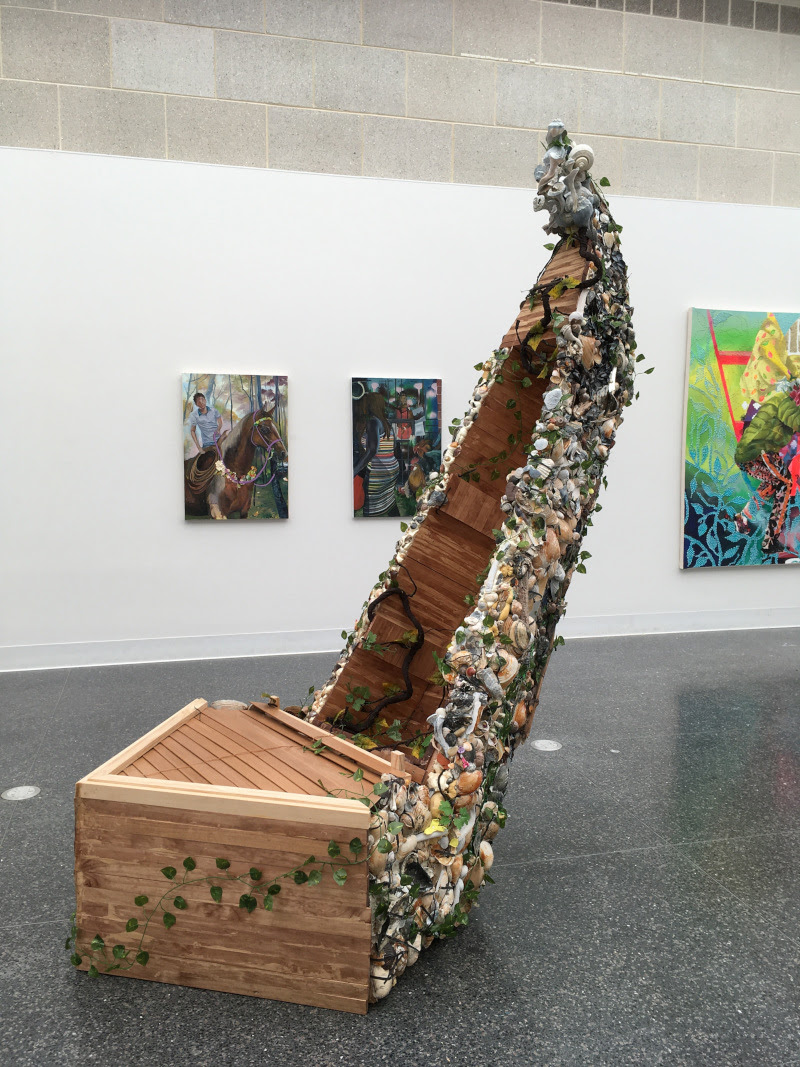In the Eye of the World
Cedar Crest College Center for Visual Research through Dec, 4th
Cedar Crest College, Center for Visual Research presents “In the Eye of the World,” an exhibition of work by Daphne Arthur (b. 1984, Caracas, Venezuela). Combining paintings, smoke, sound, and sculptures from the last five years, Arthur’s work demonstrates mutability and fluidity of materials, heritages, and diaspora across time and space.
In her oil paintings, Arthur ruminates on the politics of everyday life through connecting materials and their changing nature with the present and past articulations. By utilizing smoke, a shifting material, Arthur highlights the organic nature of her practice. Inspired by her experience as the daughter of Trinidadian immigrants in Venezuela, Arthur foregrounds history in recasting the material artifacts of the past and offering depictions of the personal mythologies that families reproduce. In particular, through engaging the theme of movement and confronting the histories of chattel, travelers, and migrants, Arthur offers a cyclical depiction of her family’s history—traveling by boat from Trinidad to Venezuela and ultimately to the shores of Queens.
Arthur illustrates the beach, ocean, and horizon as opportunities to escape from external pressures through highlighting the natural purity of landscapes and encouraging a heightened awareness of the ethereal, the living, and organic. Capturing eroding beach debris, whether strewn in Far Rockaway, Trinidad, or Venezuela, Arthur reflects on deterioration, transformation, and the stakes of historical change. Echoing recent and contemporary patterns of gentrification, the exhibition refocuses on the corrosion of black and brown communities and their local histories.
Portrayals of boats, black boys on horseback, and other modes of transport emphasize movement and dynamism. Arthur compels viewers to consider the multiple significations of the boat in racialization transatlantic histories—freedom, movement, bondage, enslavement, trauma. Her work suggests the dual conceptualization of the boat as a vessel of autonomy but also of captivity. Boats carried and continue to carry voyagers, travelers, exiles, asylees across space and time.
Arthur’s subjects, black women and men, often solitary but in media res, depict black historical agency. A man standing awash in light can be seen in newer, clearer perspectives—the light illuminates him and in turn is reflecting off of him. The works project the interiority of their subjects and reflect Arthur’s multi-layered family history connecting her ancestors—Merikins (former African slaves in the employ of British military units) who received land grants in Trinidad where they convened in secret to practice Afro-syncretic Spiritual/Shouter Baptist traditions. Combing the sound of gospel music sung by the artist’s grandmother and a boat sculpture, Arthur fuses resistance to shackles and the braying surf in a cacophony of reverberation and emotion.
Arthur highlights the thematic articulations of erosion as perpetual, multi-geographic (in Queens and Venezuela) and historically rooted in redlining and gentrification on the local level. In this way, Arthur’s work recalls the living history of slavery across hemispheric America, drawing on the dynamic, extant historical memory of the last African slaves brought to the United States and Afro-descendants contemporarily moving between black Atlantic spaces. Arthur presents a showcase of work that reaffirms diaspora as a living condition, in multi-sensual ways.
In the Eye of the World
On view: through December, 4th, 2020
Curated by Julia Marsh
Cedar Crest College, Center for Visual Research
100 College Drive
Allentown, PA 18104

Clotilda, 1860 by Daphne Arthur, 2020, Wood, cardboard, shells, mirrors and (25:28) soundtrack, 113 x 42.5 x 42″

Frente A Frente by Daphne Arthur, acrylic and smoke on paper 55″x42″2013
Artist Statement: I use smoke, paint, clay, and collage to explore the qualities that exist in the nature of change and impermanence.
Trails of incandescent candles, slithering drips of colors, clusters of glitter and found materials blur the line between ephemera and permanence. Beauty and decay. Intuition and cognition. Illusion and reality.
A serendipitous encounter, a walk along the shore, or a cut out from a magazine generate paintings and drawings that explore human relations, the physical realities and conspicuous nature of ephemera and memory, by framing the illusive obviousness of these realities in time and space through objectively depicted materials.
“Daphne Arthur’s smoke on paper, employ an interesting technique. Her drawings remind one of tableaux vivants, or stage-like pieces that convey the unmistakable feeling of entering a room. Arthur has made her work teem with narrative and life. She is telling a complex story, yet shrouding the narrative in a complicated set of visual techniques. With the drawing Marks of Dust That Wander, specks of gold leaf nearly float off the paper and rest on the eye, making the work both precious and ominous, like a too fattening piece of cake asking to be eaten. Even without knowing the medium, one still senses the smoky and cloudy atmosphere these works possess. Shadows, the faint hint of plants, foliage and architecture all set the scene. A figure, round breast, flowing gossamer gown, the trunk of a tree, a smoky, secret garden emerge captivating and catapulting us to another culture (perhaps the Pacific Rim). Her work is a travelogue of her imagination and precise story telling. In viewing Arthur’s work, we are not here, we are there.” by Louis Zoellar Bickett, Lexington, KY
Press Release Written by James Cantres, Assistant Professor, Department of Africana and Puerto Rican/Latino Studies, Hunter College, City University of New York






